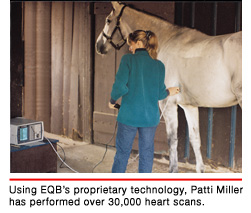Cardiovascular Analysis
Cardiovascular Analysis

Pioneers in Equine Cardiovascular Analysis — Finding the “Stuff” of Champions
“Secretariat’s heart was simply the largest I’ve ever seen . . . we suddenly understood how he was able to win the Belmont race by 31 lengths.” — Dr. Tom Swerczek, DVM who performed postmortem of Secretariat.
EQB’s Patented Heart Scan Technique — Non-Invasive 2D Racehorse Ultrasound (Echo cardiograms)
EQB’s advanced non-invasive, Thoroughbred heart scan technique and system is patented with updates internationally patent-pending. And, published in peer reviewed refereed, respected scientific journals, as below. You may download the articles from our web site’s home page. These studies [ and all our research studies ] were designed, executed and analyzed by leading scientific luminaries in the related fields, including the head of cardiology at the University of Pennsylvania Veterinary School, a senior professor of statistics at Rutgers University, a senior professor of Computer Science and Electrical Engineering at M.I.T. and consulting MDs.
 |
The Relationship of Selected Two-dimensional Echocardiographic Measurements to the Racing Performance by Jeffrey A. Seder, AB, MBA, JD, Charles E. Vickery III, BS, and Patrice M. Miller (in Adobe PDF format) |
EQB offers worldwide cardiovascular measuring (heart scans) for bloodstock auctions, farm assessments, and aid in training and marketing decisions. EQB’s proprietary heart scanning and evaluation system is patented.
EQB’s no-nonsense approach allows us to offer the most affordable and accurate, yet simple, safe, and non-invasive technique using digitizing, computerized, portable 2D echo-ultrasound to measure a horse’s heart size, its components dimensions, and pumping volume (similar to the ultrasound used to view babies in the womb).
Over the last 30 years, EQB has measured over 50,000 great (and not so great) racehorses as yearlings and 2-year-olds, before they ever raced. For each horse, we recorded pedigree, birth date, sex, conformation, every detail of the subsequent race record, and other information. And EQB continues to measure and follow the racing careers of thousands more each year.
| By collecting detailed cardiac data on over 40,000 Thoroughbreds, EQB has developed predictive statistical models that are extremely helpful. |
The goal of EQB’s exclusive DATAJOCKEY™ — a proprietary software service that performs multivariate, discriminate, regression statistical analysis of the cardiovascular measurements — is to apply a reliable, reproducible, specific numerical probability to each horse’s racing success, with “success“ defined by distance and level of competition.
Of course, no predictions of performance for racehorses can be absolute or as simple as a single variable. Horses are prone to injury (approximately 25% are removed or lessened in competition each year by injuries) and their performance is also of course limited by the quality of their attitudes and the quality of the management they receive. It is difficult for even the best physical specimens to achieve their maximum potential. However, the vast majority of graded stakes winners, at over a mile, that we have measured as yearlings and 2-year olds, have had cardiovascular systems far superior to the average racehorse.
As documented in our unprecedented and acclaimed 2003 longitudinal heart study, published in the Journal of Equine Veterinary Science, the official journal of the World Equine Veterinary Association, and using our unique huge data bases, EQB’s proprietary DATAJOCKEY™ software can perform multivariate statistical analysis of cardiovascular measurements and other factors to attain a reliable numerical probability for a horse’s competitive potential.
Conducted over a 6-year period, the seminal published study yielded a rigorously-established, direct, strong statistically-significant link between cardiovascular characteristics and racing performance as measured in average dollar earnings per start (qualified for distances of races), and is the first study of its size and magnitude to control variables by sex, age and weight. Starting in 1995 with a sample size of over 7000 horses, the study was designed and executed by a multidisciplinary team of experts from major universities.
 |
“It’s not how fast they run, it’s how they run fast.” — Jeff Seder, President, EQB, inc. EQB’s unprecedented longitudinal equine cardiac study of over 7000 Thoroughbred racehorses was a boon to the industry. EQB’s groundbreaking study was subsequently refereed and published by the Journal of Equine Veterinary Science, and links numerous cardiac characteristics with future earnings. |
The tremendous analytical advantage produced as a result allows us to precisely compare cardiovascular characteristics and measurements of prospective Thoroughbred talent with those of past champions.
We know what the cardiovascular systems of great racehorses look like — at all ages and sizes and sexes — and can measure and assess them before purchase. Your horse is compared only to others of the same sex, size (within 25 pounds) and age (within 30 days) for whom we have racing records.
Important NOTICE Regarding EQB, Inc., Cardiac Reports on Racehorses:
EQB employs veterinarians for its research and for the interpretation of data collected. However, EQB’s technician takes measurements on a “best efforts” basis and is not a veterinarian and does not practice veterinary medicine. No representative or employee of EQB is authorized to give veterinary opinions of any kind or to make any representation whatsoever about the health of any horse, unless they are themselves a licensed veterinarian.



